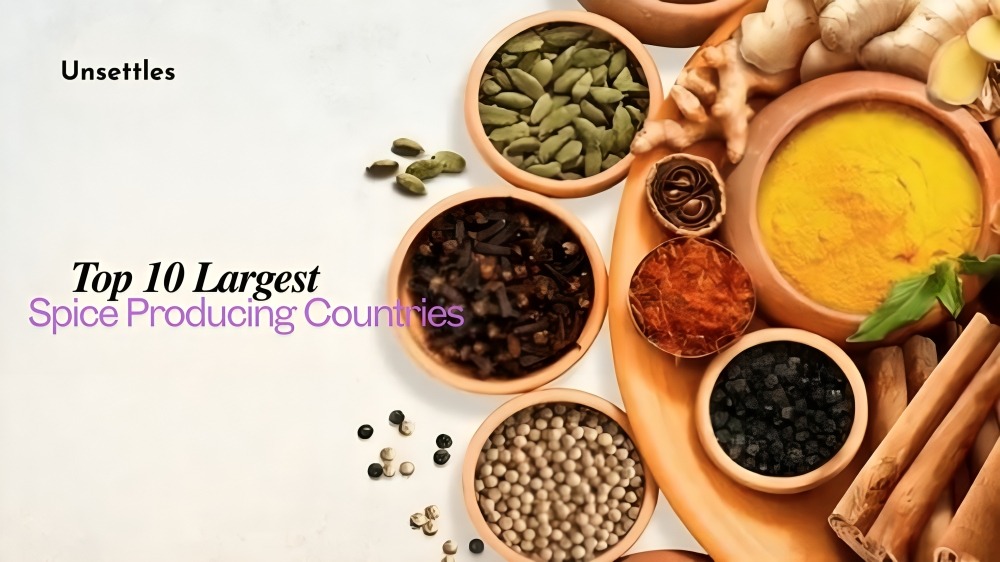Spices have been an integral part of human civilization for centuries, enhancing our culinary experiences and playing a key role in cultural traditions worldwide. As we move through 2024, certain countries have emerged as the top players in global spice production, contributing to a vibrant and essential market that serves both local and international palates. Below, we explore the top 10 spice-producing nations, delving into the diversity of their offerings and their significance in the spice trade.
1. India – 2,176,908 Metric Tons
India remains the undisputed leader in spice production, churning out a staggering 2,176,908 metric tons in 2024. Often called the “Land of Spices,” India’s varied agro-climatic zones make it ideal for cultivating a wide range of spices like cumin, cardamom, black pepper, and turmeric. From the tropical Malabar Coast to the fertile plains of Kerala, India’s spice diversity satisfies both domestic consumption and global demand. Whether it’s the warm aroma of cumin from Gujarat or the golden hues of turmeric from Andhra Pradesh, Indian spices continue to be highly sought after worldwide.
2. Turkey – 251,893.45 Metric Tons
With 251,893.45 metric tons of spices produced in 2024, Turkey stands second on the list. Known for its strategic location between Europe and Asia, Turkey’s climate is perfect for growing quality spices like red pepper, thyme, and sumac. The Mediterranean sunshine enhances the flavors of these spices, which are not only staples in Turkish cuisine but are also gaining popularity on the international market for their distinctive taste and fragrance.
3. Bangladesh – 167,205 Metric Tons
Bangladesh ranks third with 167,205 metric tons of spices produced in 2024. Fenugreek, coriander, and mustard seeds dominate the Bangladeshi spice scene, enriching both local and global dishes. Bangladesh’s focus on growing spices that are central to its culinary traditions has helped make it a key player in the spice trade. The country’s fertile lands and favorable climate make it a reliable source for a wide variety of spices, including the spicy mustard seeds and aromatic coriander that define Bangladeshi cuisine.
4. China – 104,766 Metric Tons
China produced 104,766 metric tons of spices in 2024, placing it fourth on the list. China’s rich culinary history relies heavily on spices like star anise, Sichuan peppercorns, and ginger. These spices are deeply ingrained in Chinese cooking and culture. Star anise, with its licorice-like flavor, is a key ingredient in Chinese five-spice powder, while Sichuan peppercorn adds the signature numbing heat to many regional dishes. China’s vast and varied landscape continues to support a growing spice industry that caters to both domestic and global markets.
5. Indonesia – 96,849 Metric Tons
Indonesia’s spice production reached 96,849 metric tons in 2024, placing it fifth globally. Known for producing iconic spices such as cloves, nutmeg, and cinnamon, Indonesia’s archipelago provides the ideal tropical conditions for spice cultivation. The legendary Spice Islands (Moluccas) are famous for their cloves, while Sumatra and Java are major producers of aromatic cinnamon. Indonesia’s contribution to the global spice market remains significant, enriching kitchens worldwide with its exotic spices.
6. Pakistan – 45,950 Metric Tons
Pakistan produced 45,950 metric tons of spices in 2024, ranking sixth. Cumin, red chili, and turmeric are the key spices grown in the country, which not only meet local culinary preferences but also serve international markets. The sun-drenched fields of Pakistan produce red chilies with a distinctive heat, while cumin and turmeric are staples in traditional dishes. Pakistan’s spice production continues to grow, reflecting the country’s commitment to quality and authenticity in its spice offerings.
7. Ethiopia – 39,738 Metric Tons
Ethiopia’s spice production reached 39,738 metric tons in 2024, placing it seventh on the list. Ethiopian cuisine is known for its bold flavors, and the country’s spice industry focuses on black cumin, fenugreek, and coriander. Ethiopian spices are an integral part of the nation’s cultural and culinary identity, with traditional dishes like injera and berbere highlighting their importance. Ethiopia’s spice production not only serves local needs but also contributes unique flavors to the global market.
8. Nepal – 372,000 Metric Tons
Nepal produced 372,000 metric tons of spices in 2024, with cardamom, ginger, and turmeric being the primary contributors. The Himalayan nation’s rugged terrain and unique climate are ideal for growing high-quality cardamom, known for its sweet and citrusy fragrance. Ginger and turmeric also thrive in Nepal’s fertile soil, adding to the country’s spice repertoire. Nepal’s spices are highly valued both domestically and internationally for their purity and flavor.
9. Colombia – 12,515 Metric Tons
Known more for its coffee, Colombia also made its mark in the spice industry with 12,515 metric tons of production in 2024. Achiote and cilantro are the primary spices grown in the country, adding distinctive flavors to both local and global cuisines. While Colombia’s spice industry is relatively small compared to others, it offers unique contributions, enriching the global spice trade with its diverse agricultural landscape.
10. Myanmar – 9,454 Metric Tons
Myanmar rounds out the top 10 with 9,454 metric tons of spices produced in 2024. Known for its ginger, turmeric, and cardamom, Myanmar’s spice industry is modest but growing. The country’s spices are sought after for their unique flavors, and Myanmar’s spice sector continues to evolve to meet the demands of both local and international markets.
Conclusion
The top 10 spice-producing countries in 2024 showcase a rich and diverse tapestry of flavors and aromas that influence global cuisines. From India’s vast spice variety to the distinctive offerings of Turkey and Bangladesh, each country contributes its own unique flavor to the world. As consumer preferences evolve, these nations will continue to play a crucial role in satisfying the global appetite for spices, enhancing dishes and culinary traditions across the globe.
